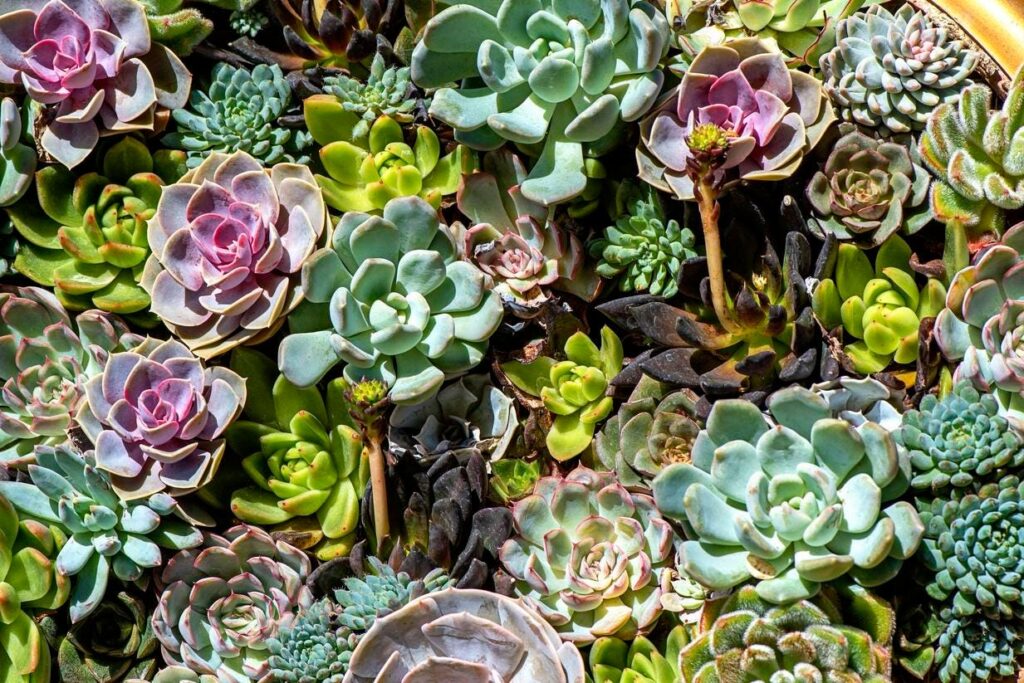Can a garden be beautiful, sustainable and fire-resistant? Is this even a question you would have asked six or 12 months ago? Recent wildfires in Los Angeles and Western North Carolina have prompted rethinking our outdoor spaces. Google searches for “fire resistant plants” hit an all-time high this year along the West Coast and “succulents” are a top eco-friendly plant being searched online. Here’s what you should be thinking about when planning a garden project, according to experts.
Adding Sustainability
Having a sustainable garden means incorporating native plants that will thrive in your soil with less fertilizer and water. That entails different species in the humid Southeast than the arid Southwest and it’s best to consult with local experts on the best choices for your area, light conditions and property.
One aspect of sustainability that is less often discussed when it comes to gardens and landscape is resilience. Plants and other elements that will hold up well in local conditions are more eco-friendly than those that will suffer from factors like heat, salt water or excessive moisture. Planning for durability is more sustainable than having to replace poorly chosen features every few years.
‘We define sustainability as long-term performance—ecologically and structurally,” shares Tryggvi Thorsteinsson, principal architect at Los Angeles-based Minarc, adding, “Fire safety, water use, and low maintenance must all align.”
Adding Resilience
Resilience, particularly against wildfires in high risk areas, should be both a durability and sustainability issue. “Some native plants are more fire-prone than others due to oils and seasonal drying. The focus should be on noncombustible or low-ignition species, many of which are also drought-tolerant — such as succulents. With careful selection, it is possible to achieve both water conservation and fire resilience, but not all native plants are appropriate,” the architect suggests.
“Fire-resistant is not enough—everything exposed to the elements should be noncombustible,” he clarifies. “Landscape materials, fences, and exterior structures all contribute to fire spread, and they must be part of the solution, not the problem.”
Lindsay Ono, president of the California Landscape Contractors Association and a horticulture professor at Bakersfield College, observes, “Ultimately, a well-planned fire-safe landscape design does more than beautify a property. It serves as a frontline defense, reducing the likelihood of fire spreading to fences, outbuildings, and — most importantly — the home itself.”
In addition to properly choosing fire-resistant plants and ground cover, Ono suggests, “Steer clear of species that drop large amounts of leaves, bark, seed pods, or needles, as this debris can accumulate quickly and become fuel for embers. Trees and shrubs that retain dead branches or trap debris within their canopies can also increase fire risk. Additionally, plants with strong, aromatic scents—such as some herbs and evergreens—often contain high levels of oils or resins, which can burn hotter and faster.”
“Take time to walk the perimeter of your home and look for vulnerable areas where embers or flames could travel from nearby structures, vegetation, or debris,” he advises. “Understanding and applying the principles of Defensible Space Zones—as outlined by Cal Fire’s Ready for Wildfire program—can help you create a more fire-resilient property.
Unexpected Risk
Homeowners in Western North Carolina probably didn’t expect to be facing severe wildfires, particularly not months after a surprise hurricane struck the area. “The flooding left behind a lot of dead vegetation and unstable slopes, which became fuel during the fires,” observes Jason Keeley a gardener and founder of lawn care company Mowing Magic. “Also, erosion control measures post-flood weren’t always fire-conscious.”
The entrepreneur points to firm projects in the affected counties that held up well: “We designed them with ‘hardscape buffers’ — gravel pathways, patios and stone walls — that created natural firebreaks. In these cases, even when the fire approached, it lost intensity before reaching structures.”
Keely adds, “Several of our more recent projects were developed with fire-resistance in mind, especially for homes near forests or with sloped lots. We use xeriscaping techniques, native perennials with high moisture content, and non-flammable mulch alternatives. We also educate clients on regular maintenance like clearing debris and pruning low tree limbs to avoid ladder fuels.” He anticipates that local governments will be implementing stricter defensible space codes and mandating the use of fire-resistant plants and materials close to homes.
Last Words
A garden should not only enhance the fire resilience and sustainability of your home but should also delight your senses. “A fire-safe landscape doesn’t have to resemble a barren desert,” Ono points out. “In fact, it can be vibrant, artistic, and environmentally friendly. Thoughtful design choices—like incorporating gravel pathways and flowerbeds—can not only enhance the aesthetic appeal of a yard but also serve a critical function in wildfire prevention. These pathways act as natural firebreaks, helping to stop ground fires from spreading while also guiding the eye to key focal points throughout the garden.” When selecting plants, he suggests looking for interesting foliage, unique branching patterns or bold textures that can serve as focal points. If they happen to be native succulents that will delight your eye and reduce wildfire risk, that’s a win-win!
***
Note: All interviews were conducted by email in the week ending April 20, 2025.
Read the full article here

